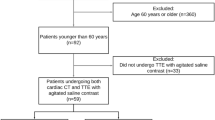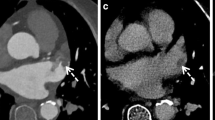Abstract
Objectives
We explored the hypothesis that the diagnostic performance of cardiac computed tomography (CT) throughout the full cardiac cycle would be superior to single-phase CT and comparable to transesophageal echocardiography (TEE) in diagnosing patent foramen ovale (PFO).
Methods and results
From May 2011 to April 2015, 978 patients with stroke were diagnosed with PFO by TEE. In patients with stroke, cardiac CT was performed if the patients had more than two cardiovascular risk factors. We prospectively enrolled 70 patients with an indication for cardiac CT. Cardiac CT images were reconstructed at 10% increments of the R-R interval. The sensitivity of cardiac CT throughout the full cardiac cycle in diagnosing PFO was compared to that for TEE and single-phase cardiac CT. To evaluate the specificity of cardiac CT, we analyzed patients without PFO confirmed by TEE who underwent cardiac CT within 1 month of pre-cardiac surgery. Sixty-six patients with cardiac CT and TEE were included in the final analysis. Throughout the full cardiac cycle, cardiac CT had a sensitivity of 89.4% and a specificity of 92.3% in diagnosing PFO, compared to TEE as a reference. PFO was primarily detected in the 60% and 70% intervals in 10-phase reconstructed images. The sensitivity of PFO diagnosis with cardiac CT was 81.8% when analyzing both the 60% and 70% intervals instead of the full cardiac cycle.
Conclusion
Cardiac CT throughout the full cardiac cycle outperforms single-phase cardiac CT in detecting PFO. Cardiac CT can be used as an alternative method to TEE for detecting PFO in stroke patients.
Key Points
• Throughout the full cardiac cycle, cardiac computed tomography (CT) had a sensitivity of 89.4% and a specificity of 92.3% in diagnosing patent foramen ovale (PFO), compared to transesophageal echocardiography.
• The sensitivity of diagnosing patent foramen ovale with cardiac CT was 81.8% when analyzing 60% and 70% R-R intervals instead of the full cardiac cycle.
• Cardiac CT with retrospective electrocardiographic gating throughout the full cardiac cycle can increase the detectability of PFO, compared to single-phase cardiac CT.




Similar content being viewed by others
Abbreviations
- CAOD:
-
Coronary artery occlusive disease
- CT:
-
Computed tomography
- ECG:
-
Electrocardiography
- IAS:
-
Interatrial septum
- LA:
-
Left atrium
- LAVI:
-
Left atrial volume index
- NPV:
-
Negative predictive value
- PFO:
-
Patent foramen ovale
- PPV:
-
Positive predictive value
- RA:
-
Right atrium
- TEE:
-
Transesophageal echocardiography
References
Beacock DJ, Watt VB, Oakley GD, Al Mohammad A (2006) Paradoxical embolism with a patent foramen ovale and atrial septal aneurysm. Eur J Echocardiogr 7:171–174
Handke M, Harloff A, Olschewski M, Hetzel A, Geibel A (2007) Patent foramen ovale and cryptogenic stroke in older patients. N Engl J Med 357:2262–2268
Williamson EE, Kirsch J, Araoz PA et al (2008) ECG-gated cardiac CT angiography using 64-MDCT for detection of patent foramen ovale. AJR Am J Roentgenol 190:929–933
Mas JL, Arquizan C, Lamy C et al (2001) Recurrent cerebrovascular events associated with patent foramen ovale, atrial septal aneurysm, or both. N Engl J Med 345:1740–1746
Siostrzonek P, Lang W, Zangeneh M et al (1992) Significance of left-sided heart disease for the detection of patent foramen ovale by transesophageal contrast echocardiography. J Am Coll Cardiol 19:1192–1196
Movsowitz HD, Movsowitz C, Jacobs LE, Kotler MN (1993) Negative air-contrast test does not exclude the presence of patent foramen ovale by transesophageal echocardiography. Am Heart J 126:1031–1032
Stewart MH, Gilliland Y (2018) Role of transesophageal echocardiography in patients with ischemic stroke. Prog Cardiovasc Dis 61:456–467
Calvet D, Touzé E, Varenne O, Sablayrolles JL, Weber S, Mas JL (2010) Prevalence of asymptomatic coronary artery disease in ischemic stroke patients: the PRECORIS study. Circulation 121:1623–1629
Yoo J, Yang JH, Choi BW et al (2012) The frequency and risk of preclinical coronary artery disease detected using multichannel cardiac computed tomography in patients with ischemic stroke. Cerebrovasc Dis 33:286–294
Boxt LM, Lipton MJ, Kwong RY, Rybicki F, Clouse ME (2003) Computed tomography for assessment of cardiac chambers, valves, myocardium and pericardium. Cardiol Clin 21:561–585
Funabashi N, Asano M, Sekine T, Nakayama T, Komuro I (2006) Direction, location, and size of shunt flow in congenital heart disease evaluated by ECG-gated multislice computed tomography. Int J Cardiol 112:399–404
Cademartiri F, Mollet N, van der Lugt A et al (2004) Non-invasive 16-row multislice CT coronary angiography: usefulness of saline chaser. Eur Radiol 14:178–183
Incedayi M, Öztürk E, Sonmez G et al (2012) The incidence of left atrial diverticula in coronary CT angiography. Diagn Interv Radiol 18:542–546
Funabashi N, Maeda F, Nakamura K et al (2007) Channel-like appearance of a patent foramen ovale with left to right shunt demonstrated by 64-slice computed tomography. Int J Cardiol 119:119–121
Saremi F, Attai SF, Narula J (2007) 64 multidetector CT in patent foramen ovale. Heart 93:505
Kim YJ, Hur J, Shim CY et al (2009) Patent foramen ovale: diagnosis with multidetector CT--comparison with transesophageal echocardiography. Radiology 250:61–67
Moorrees J, Bezak E (2012) Four dimensional radiotherapy: a review of current technologies and modalities. Australas Phys Eng Sci Med 35:399–406
Numata S, Tsutsumi Y, Ohashi H (2012) Evaluation of stuck mechanical valve with four-dimensional computed tomography. Eur J Cardiothorac Surg 42:594
Lilly LS, Braunwald E (2018) Braunwald’s heart disease: a textbook of cardiovascular medicine, 11th edn, Elsevier Health Sciences
Luotolahti M, Saraste M, Hartiala J (1995) Saline contrast and colour Doppler transoesophageal echocardiography in detecting a patent foramen ovale and right-to-left shunts in stroke patients. Clin Physiol 15:265–273
Sun JP, Stewart WJ, Hanna J, Thomas JD (1996) Diagnosis of patent foramen ovale by contrast versus color Doppler by transesophageal echocardiography: relation to atrial size. Am Heart J 131:239–244
Kim YD, Song D, Nam HS et al (2017) Increased risk of cardiovascular events in stroke patients who had not undergone evaluation for coronary artery disease. Yonsei Med J 58:114–122
Saremi F, Channual S, Raney A et al (2008) Imaging of patent foramen ovale with 64-section multidetector CT. Radiology 249:483–492
Flachskampf FA, Badano L, Daniel WG et al (2010) Recommendations for transoesophageal echocardiography: update 2010. Eur J Echocardiogr 11:557–576
Rodrigues AC, Picard MH, Carbone A et al (2013) Importance of adequately performed Valsalva maneuver to detect patent foramen ovale during transesophageal echocardiography. J Am Soc Echocardiogr 26:1337–1343
Wu CC, Chen WJ, Chen MF, Liau CS, Chu SH, Lee YT (1993) Left-to-right shunt through patent foramen ovale in adult patients with left-sided cardiac lesions: a transesophageal echocardiographic study. Am Heart J 125:1369–1374
Lang RM, Badano LP, Mor-Avi V et al (2015) Recommendations for cardiac chamber quantification by echocardiography in adults: an update from the American Society of Echocardiography and the European Association of Cardiovascular Imaging. Eur Heart J Cardiovasc Imaging 16:233–271
Groeneveld NS, Guglielmi V, Leeflang MMG et al (2020) CT angiography vs echocardiography for detection of cardiac thrombi in ischemic stroke: a systematic review and meta-analysis. J Neurol 267:1793–1801
Resen MS, Poulsen MB, Overgaard K et al (2020) Cardiovascular computed tomography versus transoesophageal echocardiography after cryptogenic ischaemic stroke - a pilot study of 12 patients. J Int Med Res 48:300060518764220
Strunk BL, Cheitlin MD, Stulbarg MS, Schiller NB (1987) Right-to-left interatrial shunting through a patent foramen ovale despite normal intracardiac pressures. Am J Cardiol 60:413–415
Attaran RR, Ata I, Kudithipudi V, Foster L, Sorrell VL (2006) Protocol for optimal detection and exclusion of a patent foramen ovale using transthoracic echocardiography with agitated saline microbubbles. Echocardiography 23:616–622
De Castro S, Cartoni D, Fiorelli M et al (2000) Morphological and functional characteristics of patent foramen ovale and their embolic implications. Stroke 31:2407–2413
Hausmann D, Mügge A, Becht I, Daniel WG (1992) Diagnosis of patent foramen ovale by transesophageal echocardiography and association with cerebral and peripheral embolic events. Am J Cardiol 70:668–672
Hendel RC, Berman DS, Di Carli MF et al (2009) ACCF/ASNC/ACR/AHA/ASE/SCCT/SCMR/SNM 2009 appropriate use criteria for cardiac radionuclide imaging: a report of the American College of Cardiology Foundation Appropriate Use Criteria Task Force, the American Society of Nuclear Cardiology, the American College of Radiology, the American Heart Association, the American Society of Echocardiography, the Society of Cardiovascular Computed Tomography, the Society for Cardiovascular Magnetic Resonance, and the Society of Nuclear Medicine Endorsed by the American College of Emergency Physicians. J Am Coll Cardiol 53:2201–2229
Song D, Kim YD, Hong K-S et al (2016) Scientific statement for screening of coronary artery disease in patients with ischemic stroke. J Korean Neurol Assoc 34:91–98
Funding
This study has received funding by the Korea Medical Device Development Fund grant funded by the Korean government (the Ministry of Science and ICT, the Ministry of Trade, Industry and Energy, the Ministry of Health & Welfare, Republic of Korea, the Ministry of Food and Drug Safety) (Project Number: 202016B02).
Author information
Authors and Affiliations
Corresponding author
Ethics declarations
Guarantor
The scientific guarantor of this publication is Dr. Chang Hyuk-Jae.
Conflict of Interest
The authors of this manuscript declare no relationships with any companies whose products or services may be related to the subject matter of the article.
Statistics and Biometry
No complex statistical methods were necessary for this paper.
Informed Consent
Written informed consent was obtained from all subjects (patients) in this study.
Ethical Approval
Institutional Review Board approval was obtained.
Methodology
• Retrospective
• Experimental
• Performed at one institution
Additional information
Publisher’s note
Springer Nature remains neutral with regard to jurisdictional claims in published maps and institutional affiliations.
Rights and permissions
About this article
Cite this article
Lee, S., Kim, IC., Kim, Y.D. et al. The role of cardiac CT throughout the full cardiac cycle in diagnosing patent foramen ovale in patients with acute stroke. Eur Radiol 31, 8983–8990 (2021). https://doi.org/10.1007/s00330-021-08037-y
Received:
Revised:
Accepted:
Published:
Issue Date:
DOI: https://doi.org/10.1007/s00330-021-08037-y




